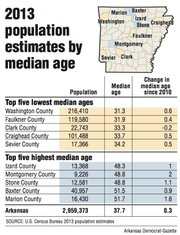Counties in the state that are losing population also tend to be the counties with rising median ages, according to new population statistics that the U.S. Census Bureau released today.
Arkansas' median age increased from 37.4 years in the 2010 census to 37.7 years in 2013, a trend that reflects the national rise in age. The United States' median age went up slightly from 37.5 in April 2010, the time period of the previous census, to 37.6 on July 1, 2013, the time period the census uses to update annual population statistics.
Population estimates were released to the media Tuesday by the U.S. Census Bureau on an embargoed basis.
The median age is one measurement used to track how a population is aging, said Michael Pakko, state economic forecaster at the Institute for Economic Advancement at the University of Arkansas at Little Rock. An increase in the median age indicates an aging population, he said.
The aging baby boom generation is the primary reason for the national rise in median age, said D'Vera Cohn, a spokesman for the Pew Research Center, a nonpartisan organization that studies social issues, public opinion and demographic trends in the United States. The center is not involved in advocacy work.
The baby boom generation refers to people born between 1946 and 1964, and as they age, they are expected to have an impact on services provided to older adults, she said. The Pew Research Center estimates that 10,000 baby boomers a day are turning 65.
"That is going to have a huge impact on population change," she said. "The older population is growing at a faster rate than the younger population. That would drive the median age up."
In Arkansas, counties experiencing greater increases in median age tend to be the same counties experiencing lower rates of population growth, Pakko said. In 2013, the county with the highest median age was Marion County at 51.7, while the youngest median age was in Washington County at 31.3.
"Areas that are declining in population are losing working-age people to urban areas, leaving behind the older folks," Pakko said. "We're seeing the places that are growing rapidly are also the ones that are declining in median age."
Jerry Mitchell, director of the Harrison-based Area Agency on Aging for Northwest Arkansas, estimated that 110,000 people 60 years and older live in the nine-county area that the agency serves, with the agency annually having contact with about 30,000 of them.
Mitchell estimates that the population of adults age 60 and older grows 15 percent to 20 percent each year in Northwest Arkansas.
With no increases expected in funding from the state or federal government, Agencies on Aging is working to develop partnerships with corporations, churches, civic groups and individual volunteers, Mitchell said. It also is encouraging older adults to adopt healthier lifestyles that incorporate exercise to help them delay the need for services.
The agency annually raises $1.5 million to support about 25 senior citizen centers, Mitchell said. The agency receives most of its funding from the state and federal government, and annually spends about $18 million on services and employs 675 to 700 employees, with the majority working the agency's in-home health care program.
"Our population is increasing," he said. "We've got more people who are coming on."
In the 2015 legislative session, state Rep. David Meeks, R-Conway, said two primary focuses for the House Committee on Aging, Children and Youth, Legislative Affairs & Military, will be on health care -- including policies designed to attract physicians to practice in the state so that enough doctors are available -- and on making Arkansas "retirement friendly." He's interested in exempting military retirement pay from state income taxes so that retired servicemen will want to live in and stay in Arkansas.
He is interested in making sure funding is available for transportation and senior citizen centers operated through the Area Agencies on Aging, he said. Legislators in the past have allocated surplus money to senior citizen centers.
Complex factors influence population changes within the state and counties, Pakko said. Population changes reflect natural growth, births minus deaths, as well as people relocating to or moving out of a county.
Most of the population increases in the fastest growing counties in Arkansas are attributable to people moving in rather than to natural growth, he said.
Arkansas' population grew by 43,457 people, from 2,915,916 at the time of the 2010 Census, to an estimate 2,959,373 in 2013, an increase of 1.5 percent.
A census ranking of the 100 fastest growing counties nationwide included just two from Arkansas -- Washington County at No. 81 and Saline County at No. 82, according to the new population estimates.
"The people who move from rural to urban settings are typically moving in response to economic opportunity, so you end up with that flow being dominated by younger working-age population, rather than retired people who have a greater tendency to stay where they are," he said.
Metro on 06/26/2014

